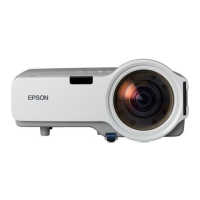Glossary
65
SNMP An abbreviation for Simple Network Management Protocol, which is the protocol for monitoring and controlling devices such as routers
and computers connected to a TCP/IP network.
SNMP Trap IP address This is the IP addressg for the destination computer used for error notification in SNMP
Squeeze mode In this mode, wide-screen images in 16:9 mode are compressed in the horizontal direction so that they are stored on the recording
medium as 4:3 images.
When these images are played back by the projector in squeeze mode, they are restored to their original 16:9 format.
sRGB An international standard for color intervals that was formulated so that colors that are reproduced by video equipment can be handled
easily by computer operating systems (OS) and the Internet. If the connected source has an sRGB mode, set both the projector and the
connected signal source to sRGB.
Subnet mask This is a numerical value that defines the number of bits used for the network address on a divided network (subnet) from the IP address.
SVGA A type of video signal with a resolution of 800 (horizontal) ^ 600 (vertical) dots that is used by IBM PC/AT-compatible computers.
S-Video A video signal which has the luminance component and color component separated to provide better image quality.
Refers to images that consist of two independent signals: Y (luminance signal) and C (color signal).
SXGA A type of video signal with a resolution of 1280 (horizontal) ^ 1024 (vertical) dots that is used by IBM PC/AT-compatible computers.
Synchronization The signals output from computers have a specific frequency. If the projector frequency does not match this frequency, the resulting
images are not of a good quality. The process of matching the phases of these signals (the relative position of the crests and the troughs in
the signal) is called Synchronization. If the signals are not synchronized, flickering, blurriness, and horizontal interference occur.
Tracking The signals output from computers have a specific frequency. If the projector frequency does not match this frequency, the resulting
images are not of a good quality. The process of matching the frequency of these signals (the number of crests in the signal) is called
Tracking. If tracking is not carried out correctly, wide vertical stripes appear in the signal.
VGA A type of video signal with a resolution of 640 (horizontal) ^ 480 (vertical) dots that is used by IBM PC/AT-compatible computers.
WXGA A type of video signal with a resolution of 1280 (horizontal) ^ 800 (vertical) dots that is used by IBM PC/AT-compatible computers.
XGA A type of video signal with a resolution of 1024 (horizontal) ^ 768 (vertical) dots that is used by IBM PC/AT-compatible computers.

